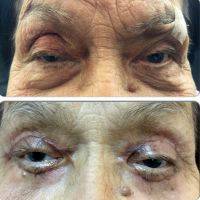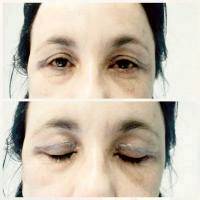Blepharoplasty Suture Removal
Blepharoplasty is a delicate surgical procedure, and the incisions are closed with delicate sutures. Most commonly, the ends of the sutures are held down to the skin at the nasal bridge and at the corner of the eyes with Steri-Strips or paper tape, until the stitches are removed by the surgeon in 5 days or so
If the sutures come out prematurely, nothing needs to be done as long as the suture line of the incision stays closed.
Take care not to rub or wash the eyelids forcefully for a few weeks
If the incision opens up, you may require re-suturing, or application of a tissue glue to hold the skin closure during the initial healing phase.
Suture irritation
Suture irritation can occur with both non-dissolving and dissolving sutures and is treated by removing the sutures.
At 9 days, there should be no problem with removing eyelid sutures, even if they will continue to dissolve on their own
The irritation may be from something else, but at least removing them may solve the problem and if not, help discover what the specific problem actally is.
Absorbable Sutures in Eyelid Surgery: Don’t Worry
The first piece of advice I will give is : Don’t worry, the sutures will be gone very soon.
The reason I prefer permanent (removable) monofilament sutures for upper eyelid surgery is that there is less initial tissue reaction than with absorbable sutures
Although the variant of absorbable suture probably used in your case is designed to dissolve in 6-7 days, it can last longer in certain circumstances.
At 1 year, it won’t make a difference because eyelid surgery scars almost invariably heal withe minimal scarring
It sounds like you had a running subcuticular suture and you accidently pulled it out. You must be very careful not to fully separate your incision. The skin of the eyelids is quite thin and since there is litte tension on it you may be okay
Avoid rubbing your eyes until you can be seen again.
Sealed and done
If your stitches came out two days ago and everything still looks closed, then you are probably fine. Many surgeons remove their stitches at the 2-3 day mark to minimize the cross hatching that can occur from them
See your surgeon and he/she will be able to allay your fears.
The stitches that hold your eyelids together should be durable enough to stay intact. In order the pull them out, some trauma would be required and that would injure the eyelids as well. Most likely, there is some extra suture material that was stuck to your skin and fell off after two days
Overall it is best though to ask your surgeon so that he/she can determine if more stitches need to be placed.
You’ll be fine
Most surgeons remove sutures 5 or 6 days after a blepharoplasty (later if a laser is used for the surgery). The good news is that eyelid skin heals very well because it is very thin and the eyelids have a good blood supply
If think look like they are doing well, then most likely everything will be fine. I would be very gentle with your eyelids for a few weeks (no rubbing) and I would discuss this with your cosmetic surgeon as well
Do you mean that the sutures came out on their own? Or the surgeon removed them at 2 days. I usually remove skin sutures from a bleph on day 4 or 5. If I have used a pull-out suture that is subcuticular( or deep to the skin surface) I may leave it in for 7 days
Quite frankly there are some surgeons that remove eyelid sutures at 2-3 days. If they should have fallen out ontheir own, you may want to check with your surgeon to see if everything is OK
Absorbable Sutures in Upper Eyelid Surgery
Absorbable sutures in general are not used in upper eyelid surgery unless there is an added procedure performed on the eyelid for droopy eyelids (tosis). It takes about 60-90 days for absorbable sutures to be completely absorbed by our body
Upper eyelid sutures are not always dissolvable and might need to be removed.
Your upper eyelid sutures might need removal. Ask your surgeon. If they are the dissolvable type, depending on the material used, it may take a bit longer for them to disappear. I would call your surgeon and get the information
Sutures and Upper Eyelid Lift Procedure
If your surgeon used dissolvable sutures along the upper eyelid incision, you might be seeing the reaction of your skin to the dissolvable material. For instance, there is a material called fast absorbing gut that is commonly used as a dissolving suture
The benefit is that you do not have to remove the suture. Unfortunately, the tissue reaction that causes the sutures to dissolve on their own can create just what you describe – some redness and mild swelling
Assuming there is no infection of the eyelid incision (which is quite rare), your healing should continue to get better on its own.
Post-op changes after blepharoplasty
Redness around the site of your incisions is not uncommon. As long as it is just redness from healing and not infection, this will reoslve over time.
Redness and swelling after upper lid surgery
Usually non desolvable sutures are used after eyelid surgery. These sutures are removed within 5 days otherwise there is tendecy to form cysts. The redness could still be du to echimosis in which case it will go away
Remove the sutures
The removable sutures can cause some irritation at times. If you are concerned you can ask your surgeon to remove the sutures. However the swelling and redness is likely from the midface lift and not from the sutures
Midface lift can cause longer swelling. Also, keep in mind that if you are still using Neosporin ointment on the eyelids, this could be an allergic reaction.
Eyelid Sutures Should Not Be Forgotten
It is perfectly fine to use permanent sutures, such as Nylon, which are easily removed 4-5 days following surgery, or dissolving sutures, such as fast-absorbing gut, which usually dissolve in 5-6 days.
My surgeon is going to remove my upper eyelid sutures 9 days after blepharoplasty. Is this too long to wait?
Impossible to answer since we do not know your medical/surgical history. Usual suture removal in upper lids is 5 to 7 days/. (Darryl J. Blinski, MD, Miami Plastic Surgeon)
Suture removal
Without knowing the exact procedure done one cannot definitively answer that. Suffice it to say that it would be extremely uncommon to leave sutures in longer than that. In a standard bleph, I usually remove the sutures on post-op day 3-5. (Robert H. Hunsaker, MD, Miami Plastic Surgeon)
Sutures out post bleph
You should do fine. With upper lids I sometimes reomove sutures 5 days or so post op. This will not affect your final outcome. (Robert Brueck, MD, Fort Myers Plastic Surgeon)
Which is better-dissolving or non-dissolving sutures?
They both can leave very acceptable results, but there are many factors that can impact incision healing with dissolvable sutures. Oilier skin types can develop suture tracts with dissolvable sutures, and with non if left in too long.
I generally use non-dissolving sutures as the inflammation from dissolving sutures can make the incisions more red and slower to become less conspicuous. However if dissolvable are placed as interrupted sutures vs a running placement they tend to cause less inflammation and can allow wound fluid egress, which can speed resolution of swelling.
These are some of the issues that you can ask your surgeon about. (John R. Burroughs, MD, Colorado Springs Oculoplastic Surgeon)
Non dissolvable sutures are best
In my opinion dissolvable sutures produce the most scarring. The sutures dissolve by causing inflammation. This inflammation produces scarring. (Earl Stephenson, Jr., MD, DDS, FACS, Atlanta Plastic Surgeon)
Fortunately for you, most eyelid lacerations heal extremely well. The skin is thin, and the scars are usually correspondingly thin and flat. However, they still require about one year for final healing. As long as you are not allergic, the type of antibiotic cream should not matter.
Sunscreen on the upper eyelids usually gets in the eyes, so I would use sunglasses rather than a sunscreen. You may want to see a plastic surgeon within the next month or two. It is almost never advisable to operate again until at least 6-12 months have passed. This allows the scars to mature and soften, making evaluation of whether something should be done more appropriate. (Elliott B. Lavey, MD, Danville Plastic Surgeon)
I remove upper lid sutures between 3-5 days postop to minimize scarring. Twelve days is an excessive length of time. I do not recommend that you attempt to remove the sutures yourself. Your physician should have coverage while he is on vacation and I suggest that you call back and ask to see the covering doctor as soon as possible. (Robert L. Kraft, MD, FACS, New York Plastic Surgeon)
12 days post blepharoplasty
It’s difficult to say why this occurred, but I would listen to your surgeon and follow his/her instructions. Sometimes, it does take longer to heal. (Elbert T. Cheng, MD, San Jose Facial Plastic Surgeon)
Humiliation and shame are very powerful emotions. Certainly if you are so disfigured that you are embarrassed by these scars, then it is certainly reasonable to consider surgical revision. However, it is also worth your while to be assessed objectively by an eyelid surgeon.
Do they agree that the scars are disfiguring? Sometimes we focus on issues that almost no one else sees. If this is the case, will surgical revision be helpful to address the issue or result in a situation that is no better?
Upper blepharoplasty sutures
In my practice, I routinely remove the upper blepharoplasty sutures at 5-7 days to minimize scarring and reaction to the suture material. (Edwin Ishoo, MD, Cambridge Facial Plastic Surgeon)
Time will resolve these bumps. Presumably your surgeon has removed the remaining suture. If not this should be done. The bumps typically fully resolve. Occasionally, a small cyst can form. This is so common, it can not be regarded as a complication, more an annoyance.
These cysts should they form are easily dealt with in the office setting. It is impossible to know at this point if any of these bumps will be come cysts but time will determine this. (Kenneth D. Steinsapir, MD, Beverly Hills Oculoplastic Surgeon)
Blepharoplasty suture removal
I remove upper lid sutures between 3-5 days postop to minimize scarring. Twelve days is an excessive length of time. I do not recommend that you attempt to remove the sutures yourself. Your physician should have coverage while he is on vacation and I suggest that you call back and ask to see the covering doctor as soon as possible. (Robert L. Kraft, MD, FACS, New York Plastic Surgeon)
Upper blepharoplasty sutures
In my practice, I routinely remove the upper blepharoplasty sutures at 5-7 days to minimize scarring and reaction to the suture material. (Edwin Ishoo, MD, Cambridge Facial Plastic Surgeon)
One week post-op lower blepharoplasty
It is not unusual to see suture marks or tracks, and a “crimped” effect early after suture removal. This should look better as the days and weeks go by. Follow your surgeons recommendations for medication or lubrication – there are different opinions on post-op care.
I am a believer in lubrication to avoid tracks and keratin build-up. on your healing. (Sara A. Kaltreider, MD, Charlottesville Oculoplastic Surgeon)
Blepharoplasty suture removal
I remove upper lid sutures between 3-5 days postop to minimize scarring. Twelve days is an excessive length of time. I do not recommend that you attempt to remove the sutures yourself. Your physician should have coverage while he is on vacation and I suggest that you call back and ask to see the covering doctor as soon as possible. (Robert L. Kraft, MD, FACS, New York Plastic Surgeon)









